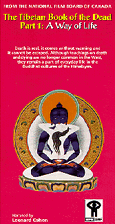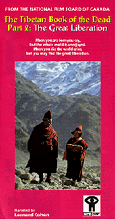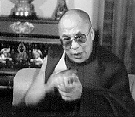

![]()
The Tibetan Book of the Dead

Part 1: | 
Part 2: |
Adults.
****/4
Review by Ian Stewart.
excerpt:
When you are born you cry,
but the whole world is overjoyed.
When you die the whole world cries,
but you may find the great liberation.
THE HARSH BEAUTY of the forbidding Himalayas provides the backdrop for much of the documentary The Tibetan Book of the Dead. The principaility of Ladakh, formerly Western Tibet, nestled between Pakistan and China, was chosen as it has been isolated from outside influences. Ladakh's religious practices have remained essentially unchanged since the introduction of Buddhism thirteen centuries ago. It is a mysterious, exotic world of gongs, prayer-wheels, chanting, and incense. A world where smiling, saffron-robed lamas (teachers) read strange books to the minds of the dead.
The Buddha said, "It is certain that I will die," but by this he meant the body, not the mind. For the Buddhist, the mind never dies. Mind, consciousness, one's true self, is eternally reincarnated in an uncontrolled cycle of birth and death and rebirth until it recognizes its true purpose. It must be awakened and liberated from worldly delusions and self-deceit.
Tibetan Buddhists believe that death, like life, is a process to be experienced and passed through until the time of the next reincarnation. They hold that the disembodied mind, freed from the bounds and cares of the body, is capable of hearing spoken words as it goes through the bardos (stages) of the death/rebirth experience. It can be guided through the bardos and perhaps find liberation from the eternal cycle or find a "good human birth" by hearing readings from the Bardo Thotrol (literally, "The Great Liberation Through Hearing in the Bardo). This book was translated into English in the 1920s as The Tibetan Book of the Dead.

Part I: The Way of Life follows the funerary rites of an old man. We meet his family and the holy man who agrees to read the Bardo to the deceased on his journey towards rebirth. The essential Buddhist themes of the impermanence of life, reincarnation, compassion, and the path to enlightenment are subtly explained in this portion of the film. We are left with a quiet understanding of this ancient people's world view, which is enhanced by an interview with the exiled Tibetan spiritual leader, the fourteenth Dalai Lama.
We also go to the Living/Dying Project in San Francisco. There the Tibetan Book of the Dead is read to terminally ill patients. According to Ram Dass (formerly known as Dr. Richard Alpert), the project's leader, the hope is to provide the dying with a "new metaphor" for death.
The secularized Western world views death and dying as a medical and individual failure. This uncompassionate, isolating, and narcissistic conception sucks the remaining vitality and purpose of life from the human spirit.
The patients are receptive to the readings. They take a new, sprititual control of the terrible process their bodies are going through. In the end they are prepared and understand a larger purpose in death. Compassion, acceptance, and peace go together into the new realm beyond.

Part 2: The Great Liberation gives a more detailed examination of the teaching of the Bardo Thotrol. It follows a lama and his young disciple through the readings of the Bardo to the mind of a deceased young man. Because the death had come unexpectedly, the man not reflected on the meaning of life and was unprepared for its end. The lama knows the man's mind will be unwilling to leave this world behind, and so is unlikely to understand its true nature and might not find a good human birth.
The Tibetan Book of the Dead is a marvelous documentary creation. It is excellently written, and Leonard Cohen's narration suits the theme beautifully. The cinematography is breathtaking: snow-capped, mighty moutains prinpricked by isolated towns provide suitable images of insignificant humanity in a vast, lonely, and hostile universe.
Yet this view is juxtaposed with a sensitive portrayal of Tibetan Buddhism's central tenet: To seek truth and practice compassion is the meaning and purpose of life. The characters of the lamas -- filled with joy and compassion -- imbue the film with the light of their eternal hopes for the world.
This is a film that demands multiple viewing. The subtleties of the Tibetan world view are complex. Unless students are familiar with basic themes, much of the film's value will be lost. Consequently, it should be used for courses on comparitive religion at the International Bacclaureate level or higher.
Highly recommended.
Ian Stewart works at Lord Nelson School in Winnipeg and at the University of Winnipeg Library.
To comment on this title or this review, send mail to cmeditor@mts.net.
![]()
Copyright © 1996 the Manitoba Library Association.
Reproduction for personal use is permitted only if this copyright notice
is maintained. Any other reproduction is prohibited without permission.
Published by
The Manitoba Library Association
ISSN 1201-9364
![]()